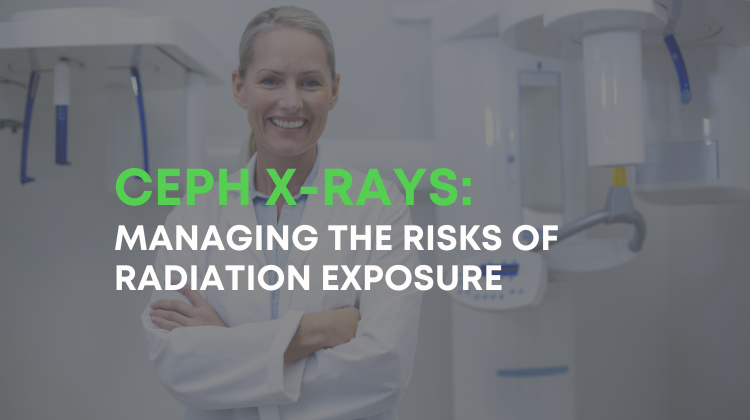Ceph X-rays: Managing the Risks of Radiation Exposure

If you’re an orthodontist, you’re familiar with the ceph X-ray. It is typically used to capture images of the teeth, jaw bone, soft tissues, and nasal and sinus passages. Since most orthodontic patients are children and teenagers, the amount of radiation they are exposed during treatment is often questioned by parents and public health officials. It’s important to understand the risks of radiation exposure and how to minimize them while still providing high-quality care.
What are the Risks?
The most effective dosage for a ceph X-ray is 5.1 to 5.6 μSv. This is about equivalent to a four image bitewing, and is a fraction of the dosage of a full mouth radiograph or CBCT image.
The primary risk with a dosage of radiation is mutation to the DNA structure. At small doses and over time, the DNA can heal itself so this isn’t an issue. However, an orthodontic patient may be receiving X-ray imaging more frequently than at other times in their life. At this young age they are also more sensitive to the effects of radiation, and they have a longer time for ill effects to develop, potentially causing cancer later in life.
Because of this, many authorities in the public health sector are promoting the use of As Low As Reasonably Achievable (ALARA) radiation dosage for all dental imaging needs.
What Can Orthodontists Do to Manage Risks?
Some dental professionals have begun using cone beam computed tomography (CBCT) in orthodontic imaging, with a slightly higher radiation dose than a 2-dimensional ceph X-ray. Orthodontists should weigh the importance and value of the information obtained from the 3-dimensional CBCT cephalometric image before prescribing a 3D scan. For this reason, it is best to implement the ALARA principle for each image capture.
Orthodontists can help protect patients and team members from radiation and radiation scatter by following state-mandated radiation protection standards. For example, all individuals unnecessary to the dental X-ray examination should leave the room prior to capturing the X-ray, dental staff should stay behind a protective barrier when exposing images, and patients should wear a 0.5 mm lead apron during cephalometric X-ray image capture.
By explaining the risks of radiation to your patients and their parents, and following the ALARA principle and radiation safety guidelines, you can provide high-quality treatment planning without causing unnecessary risk to your patients.
Contact Renew Digital
If you’re looking to purchase a newer digital ceph X-ray or replace an older analog model, please contact us online or give us a call. We would be happy to discuss your practice’s current and future needs and help you find the best certified pre-owned ceph X-ray machine for you. When you shop with Renew Digital, not only do you receive a high-quality unit at 40-60% off the manufacturer’s price, your purchase also includes professional hardware and software installation, on-site training for you and your staff, our 5 star parts and service warranty, and 24/7 remote access to the Renew Digital Help Desk if you ever have a question or need to troubleshoot a problem.
Give your patients the best care while still maintaining your budget with your dental imaging partner, Renew Digital.


%20(44).png)
%20(37).png)